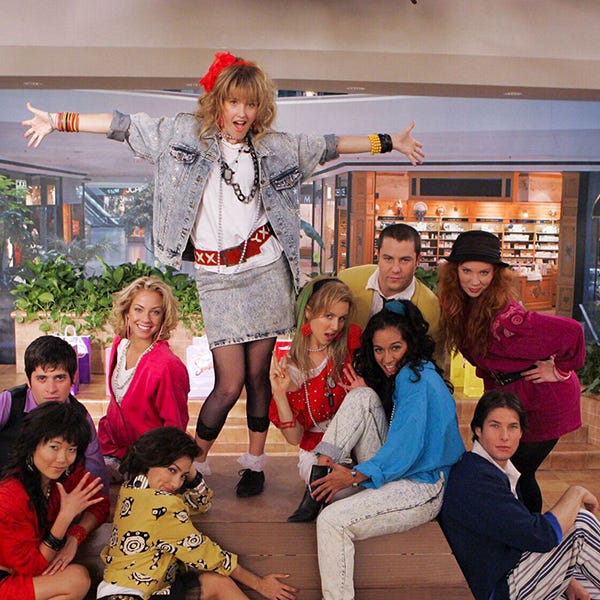The Gamification of Girlhood: An Exploration of Board Games from the 80s and 90s
A nostalgic look at the games of a female generation
Recently, my mom proudly announced at a party with friends that she took a huge amount of mine and my brother’s board games from when we were kids in the 80s and 90s to a thrift store for donation. I stopped in my tracks and asked, “Wait–which ones?” She rattled off a few names of games, and then, to my horror, she said: “and Mall Madness.” I felt my stomach drop and my face drain of color, and I truly wish I was exaggerating. Immediately I asked about the donation site and wondered if I could call them to rescue my game. The thought of it in someone else’s hands–a collector, I assumed, because I knew the game itself is valuable because of its place in gaming history–made me ill. Over the next few days, I realized just how valuable the game is (a quick search on eBay shows listings for as much as $200), and I called the thrift store at least once a day over the next week looking to keep it from sales shelves.
My copy of the original electronic talking Mall Madness published in 1989 is one of my most prized possessions, and, if I’m honest, my love for it as a kid was an early indicator of how I would approach shopping in the future. When I received the game as a gift at eight years old, I was already fascinated by consumerism (not really my fault; the overarching culture of the 1980s promoted rampant consumerism). I got excited about play money 💵 and fake credit cards 💳 from an early age. Monopoly money felt good in my hands, and I always insisted on being the banker when I played marathon games with my brother. When my mom got a new wallet, I’d steal those fake cardboard credit cards the manufacturers would put in the slots to show how many you could carry to play pretend “shopping mall” with. I loved new clothes and toys, and I understood what it meant to obtain an item on sale versus full price. My mother, a product of my Depression-era grandparents, taught me about the magical world of clearance racks and outlet stores. In short, I learned to gamify shopping as a very young child. It became a virtue.
Looking back on it through the lens of a cusp-millennial woman who believes that popular culture shapes our lives in significant ways, the existence of Mall Madness was a near-perfect amalgamation of the values of the 1980s and 1990s and how we projected those values onto women in particular. More than the shopping aspect, the mall was a haven for teens and tweens to hang out without needing too much parental supervision. In the 2004 movie Mean Girls, new girl Cady is introduced to teen culture through going to the mall with her new “Plastic” friends, and likens it to the African watering hole where she observed wild animals socializing with one another. The TV show How I Met Your Mother has a hilarious flashback episode in which Robin (Sparkles) relives the teen music video she did for the song, “Let’s Go to the Mall,” whose lyrics don’t really delve too much further because going to the mall was an event in and of itself. If you were a tween or teen in the 80s and 90s, going to the mall was synonymous with your social life.
Today, mall culture just isn’t the same, with the rise of online and curated shopping experiences. Much has been made recently of the “zombie mall,” virtually abandoned malls with empty storefronts. Even seeing a shopping mall in recent TV shows like Stranger Things and The Last of Us is nostalgic; in both of those shows, the mall itself is a signifier of a different time. Without malls, modern tween and teen girls don’t have anywhere similar to hang out (which may be why they’re taking over standalone Sephora stores instead). But when I was a kid, the mall was the place to be, and the sheer excitement of coming home with some small item you picked out with your young girlfriends by cobbling together saved allowance money was enough to sustain us and provide a steady social standing. For that reason, the game Mall Madness was a favorite amongst me and my friends. And as podcaster and author Kate Kennedynotes in her book, One In A Millennial, just like in real life for a millennial tween, “per the canon of the board game Mall Madness, the only way to lose after a day at the mall was to not buy anything.” Hence, the conditioning for girls my age to become natural consumers began.
The object of the game was to complete a shopping list with a set amount of “money,” and get back to your original location–the parking lot, of course–before the other players. Each time you entered a “store” on the (truly impressive) plastic 2-story game board, you would make a purchase by swiping a “credit card” in the electronic voice device at the game’s center. This electronic voice device would then announce how much you’d have to spend, and where the next “sales” were on the board, making the gamification of shopping stops a bit more interesting. The thing you didn’t want to have to do was visit the “ATM” for more money to complete the list, so staying on budget was key. Each of the credit cards had names which, looking back, probably instilled some unhealthy associations with credit in young players. The names were: Fast Cash (from Good Cents Bank), Quick Draw (from Dollar Daze Bank), MEGAmoney (from Big Bucks Bank), and Easy Money (from Cash n’ Carry Bank).
But what was most significant about Mall Madness is that it was marketed specifically to young girls. The box was bright pink, and there were only photographs of girls on the box cover. It was a staple at sleepovers and the girls-only playdates of my youth. Since the 1950s, women have been designated as shoppers 🛍, choosing which products their family would consume. But when women were able to obtain their own credit cards in their own names in 1974, the next female generation (mine) grew up with a sense of autonomy over their own finances and disposable income that the game Mall Madness celebrated. At the same time, it feels a bit icky that the game was marketed only to girls, not boys, suggesting that girls are destined to be fascinated by shopping while boys might be groomed for less consumerist endeavors. That said, I do remember my brother and male cousin playing the game with me often.
A quick Google search for “board games marketed to boys in the 80s and 90s” doesn’t reveal much: many of the games that came up–Guess Who?, Battleship, Operation–were equally marketed to young girls. The intended consumers/players seemed to be kids and families for most of the most popular board games of the time. But there was a swath of games marketed directly to young girls in this era: Girl Talk, Girl Talk: Secret Diary, Dream Phone, Heartthrob, etc.
It’s easy to sense a theme right away: these games flirted (pun intended) with the ideas of finding a date, a topic that excites–or worries–tweens of any generation. Games for both boys and girls were inherently escapist: a friendly game of Hungry Hungry Hippos could occupy your time with a few pals or Trivial Pursuit could challenge your knowledge of random facts. But these female-marketed games represented several aspects of adolescent life that young girls often struggle in real time to navigate: first crushes 💘, the horror of developing teen acne, and the fear that someone would read your diary 📓 and access your inner thoughts, among other humiliating rites of passage.
The object of Dream Phone, published in 1991, was to find out which guy on the gameboard was your secret crush. The game came with an electronic phone you would use to “call your crush” 📞 and see if he “liked” you back. It’s hard to look at this game in retrospect and not cringe at the heteronormative assumption (not to mention lack of gender diversity) that all girls should only be interested in boys, but there is something inspirational in the idea of simply calling the person you’re interested in to see if they like you too. I can only speak for myself, but calling up a boy I liked when I was twelve to chat could paralyze me for a few days. The game took away that anxiety, if only pretend. Still, I can’t decide if making the object of a game to obtain a boyfriend from a literal deck of cards seems either inherently sad or solid preparation for the experience of swiping on dating apps to get a match.
Similarly, the game Heartthrob centered around finding a boy to date. In fact, on the box under the “Ages” recommendation, it says, “For all girls who like boys.” Yikes! To place these games in overall pop culture history, in 1995 the controversial bestselling book The Rules was published and created a ton of discussion in the cultural zeitgeist. The tweens of the late 80s were entering the dating scene by the mid-90s, and reading a literal rulebook for dating didn’t seem that different from the gamification of scoring a pretend date (and winning the game) during an after school hang at a friend’s house.
Games like Girl Talk tackled other coming of age realities that tween girls experience. The original Girl Talk came out in 1988, a variation on the traditional (and ancient) game of Truth or Dare. Each player spins and lands on either a question or a dare. If they fail to answer the question or do the dare, they have to wear the dreaded “zit sticker” 🔴 (because what’s worse for a teenage girl than acne?!)
The Girl Talk brand soon included more games, like Girl Talk: Secret Diary and Girl Talk: Date Line (more dating games!) Secret Diary, published in 1991, left its players vulnerable to confessing their true thoughts about questions asked via a diary that came with the game. A player would choose a calendar date, open the diary to that date, and read the entry which always ended with a question. The question reader would write their answers down, and the other players would guess their answer. For each correct guess, both players could choose a calendar card to collect. Collecting a full set of 12 would win the game, and the calendar cards had–you guessed it– “cute” boys on them. The questions ranged from embarrassing to problematic with topics from body odor to weight loss. But the most insidious part? Before the game started, each player would write down a deep secret to be kept in an envelope for the winner to get to read at the end of the game.
One of the core tenets of the movie franchise Mean Girls, based on the nonfiction book Queen Bees & Wannabes by Rosalind Wiseman, is that girls naturally gamify the social experience of girlhood by using tactics that involve manipulating compliments, secret-keeping, and exploiting insecurities. Secret Diary unabashedly used these ideas as well, using personal “secrets” as game currency, over a decade before Gretchen Wieners would appear on the big screen with hair so big it’s “full of secrets.”
These games got at what was understood as universal truths about young girls: they loved shopping and the mall, they loved secrets, and they were boy crazy. It’s difficult not to look back on these games with a healthy sense of cringe. Of course, young girls were more complicated and introspective than these games would have us believe. If we learned nothing else from the Barbie movie, it's that Millennials and Generations Y and Z have spent the last few decades pushing back on the one-dimensional narratives of girlhood that toy and game companies once insisted on. And I simply cannot imagine that a game designer today could get away with publishing a game that assumes all girls are interested in boys as a prize to be won.
But all that said, I also have an intense sense of favorable nostalgia for these games. I’m sure that I learned a lot about my friends during an intense game of Secret Diary in a way I might not have by playing a less personal game. A fear of zits, (or zit stickers, as it were) turned me on to healthy skincare habits that I constantly thank my younger self for. And while I have complicated feelings about how Mall Madness turned young girls onto shopping the entire mall for sport, it also served as an introduction to budgeting and shopping within my means. (Plus, traipsing all over the mall is great exercise. As Carrie Bradshaw would later say, “Shopping is my cardio.”)
About a week after my Mall Madness game had been donated, and several phone calls to the thrift store that went nowhere, I’d finally given up and assumed my beloved game was gone forever. But a group text from both of my parents came as a surprise: they’d found my game, at the store, just as it was about to go into a special glass case, priced at $50. Thinking about my childhood game in a glass case priced for a collector seemed perfectly apt: there is a part of me that wishes to preserve the innocence of learning how to navigate the world from the comfort of a finished basement floor playing board games with my girlfriends that glorified adult activities we hadn’t had the opportunity to experience yet.
Like with most pop culture, I believe it’s important to look back on popular things of another time with a sense of context. I can still love shopping (and be proud of my useful ability to game it) while also recognizing that this isn’t a dominant female trait as these games and cultural narratives would have me believe. I can still reminisce about my friends and I getting nervous about approaching adolescence and all that would come with it by playing board games that dealt with talking to boys (or any romantic interests) head-on while lamenting the lack of gender diversity, sexual preference diversity, and general sadness that there wasn’t a better prize in these games than getting a (fake) boy to like us. This is why Instagram accounts like eightiesgirls exist: to remind us of how far we’ve come while celebrating the kids we were. But at least for now, nobody is going to pry my Mall Madness game, with its two-story plastic game board full of my memories, out of my possession anytime soon.
What were your favorite board games as a kid, and how did they shape your ideas about the world you grew up in? I would love to hear more about your experiences with board game culture in the comments!
Want more? Head over to our Discord where you’ll find tons of other fans there chatting about the TV shows, movies, music and books we all love! We have forums for TV shows, movies, books and games! You can find our watch party schedule on our app! Don’t forget to follow us on Instagram, tumblr, and Spotify for more fandom content—and hit that subscribe button so you never miss a thing at rmrk*st!








